|
G3VGR
|
LECHWEG Formarinsee - Lech am Arlberg
|
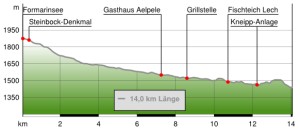 My Lechweg trip started with the 08:55 flight from Heathrow to Munich on Saturday 17th August.
On arrival, I travelled by train from the airport to Reutte via Garmisch, then caught the bus to Holzgau, arriving at the Gästehaus Alpenruh around 19:45.
As well as many beautifully painted "Lüftlmalereien" buildings, I was delighted to find Holzgau also possessed a brewery, so I was able to spend the rest of the evening there, unwinding after a long day of travelling.
My Lechweg trip started with the 08:55 flight from Heathrow to Munich on Saturday 17th August.
On arrival, I travelled by train from the airport to Reutte via Garmisch, then caught the bus to Holzgau, arriving at the Gästehaus Alpenruh around 19:45.
As well as many beautifully painted "Lüftlmalereien" buildings, I was delighted to find Holzgau also possessed a brewery, so I was able to spend the rest of the evening there, unwinding after a long day of travelling.
After breakfast, I took the scenic ride on the 4268 bus to Lech am Arlberg. In 2004, some idiots named Lech as the "most beautiful village in Europe".
I'd been here a few times during the past few years and it still looks to me like a typical soulless plastic ski resort like many others which blight the country.
Perhaps it was nice many years ago, long before all the hotels, apartments and boutiques were built.
A profusion of cranes showed that further development is under way.
Being a Sunday morning, there were many hikers about waiting for the shuttle bus.
The bus takes one along a private toll road to the "Abzweigung" (Junction) stop, where separate buses continue to either
the Spullersee or Formarinsee.
Having visited the Formarinsee in 2011 and the Spullersee in 2012, I was familiar with the area and arrived at the Formarinsee bus stop at 0950 and was welcomed by a friendly grey donkey.
From the bus stop, the highest point of the trail at 1793 metres, I headed off towards Formarinalpe in search of the Lechbach.
The trail started in earnest at the Steinbock Denkmal. This monument celebrates the re-introdution of Ibex to the area in 1958.
The local herd now numbers over 600, although I didn't see any of these shy creatures this morning.
The weather was hot and sunny as I made my way down the rough and rock-strewn path, generally following a dried stream bed.
The going was tough, but the scenery was good recompense.
Many late summer flowers were blooming as I walked in beautiful sunshine down the valley, flanked either side by some big mountains.
Occasionally I encountered clouds of both small black and also pale blue butterflies.
After about 40 minutes, I saw the first signs of the Lechbach and followed along the tiny stream.
It was joined by other springs and became a respectable brook after a while and sported a few small waterfalls.
I followed the trail as it wound it's way along the Lechbach, through limestone boulder fields until reaching the confluence with the Spullerbach, where it now became the River Lech.
There were many other walkers along the trail in both directions, so it would appear this is a popular weekend walk.
Some of the river banks are impassible and the creators of the Lechweg had built wooden platforms to ease the passage where necessary.
After passing the Gasthof Älpele, the last hour's walk was easier and softer going than the preceding 3 hours.
I was also grateful for the occasional tree cover as the early afternoon had become extremely hot.
After emerging from the last wood, a tarmac road took me the short distance into Lech.
The village centre was very busy with many visitors and I had enough time for a well-earned ice cream prior to catching the bus back to Holzgau.
The balls of my feet ached so much from the rough ground, that I didn't notice any problems relating to my fascia plantiicis injury.
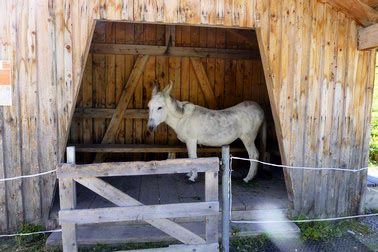
And behold! a pale donkey (in Formarinsee bus shelter)
|
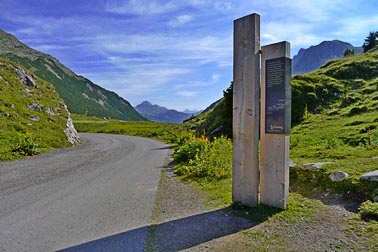
Official marker at start of Lechweg
|
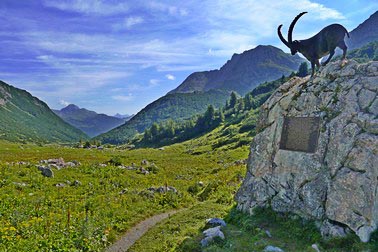
Steinbock Denkmal overlooking Lechweg
|
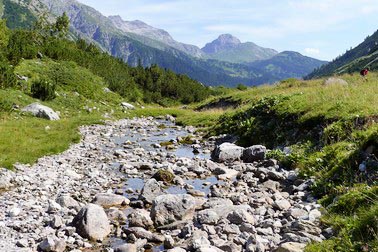
First signs of the Lechbach
|
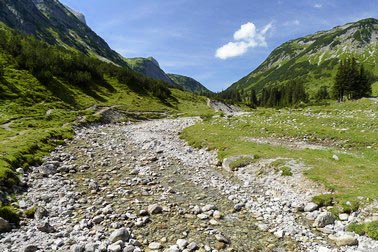
Following the young Lechbach downstream
|
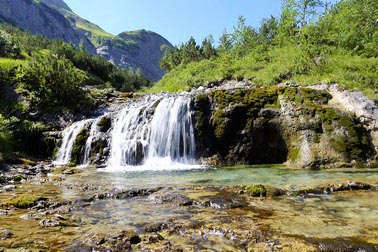
First waterfall of the Lechbach
|
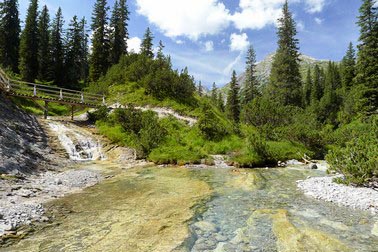
The Spullerbach joining the Lechbach from the left
|
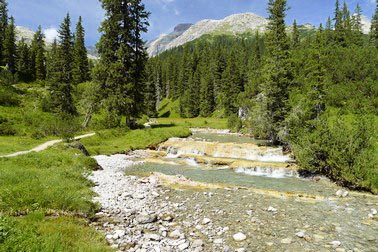
The Lech is now a river
|
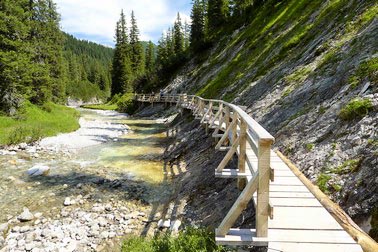
Platforms assist the walker
|
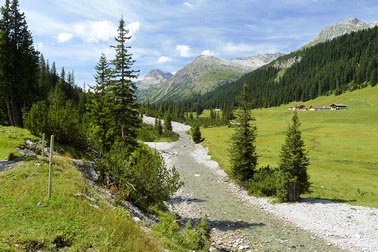
The Lech passes Gasthaus Älpele
|
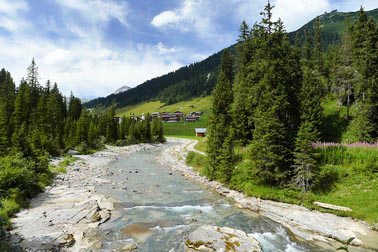
Looking back towards Zug
|
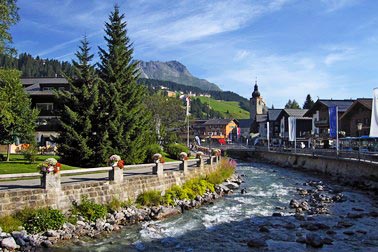
Lech am Arlberg
|
[Home]
 My Lechweg trip started with the 08:55 flight from Heathrow to Munich on Saturday 17th August.
On arrival, I travelled by train from the airport to Reutte via Garmisch, then caught the bus to Holzgau, arriving at the Gästehaus Alpenruh around 19:45.
As well as many beautifully painted "Lüftlmalereien" buildings, I was delighted to find Holzgau also possessed a brewery, so I was able to spend the rest of the evening there, unwinding after a long day of travelling.
My Lechweg trip started with the 08:55 flight from Heathrow to Munich on Saturday 17th August.
On arrival, I travelled by train from the airport to Reutte via Garmisch, then caught the bus to Holzgau, arriving at the Gästehaus Alpenruh around 19:45.
As well as many beautifully painted "Lüftlmalereien" buildings, I was delighted to find Holzgau also possessed a brewery, so I was able to spend the rest of the evening there, unwinding after a long day of travelling.









